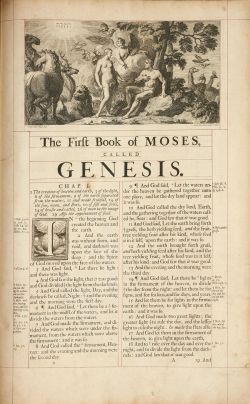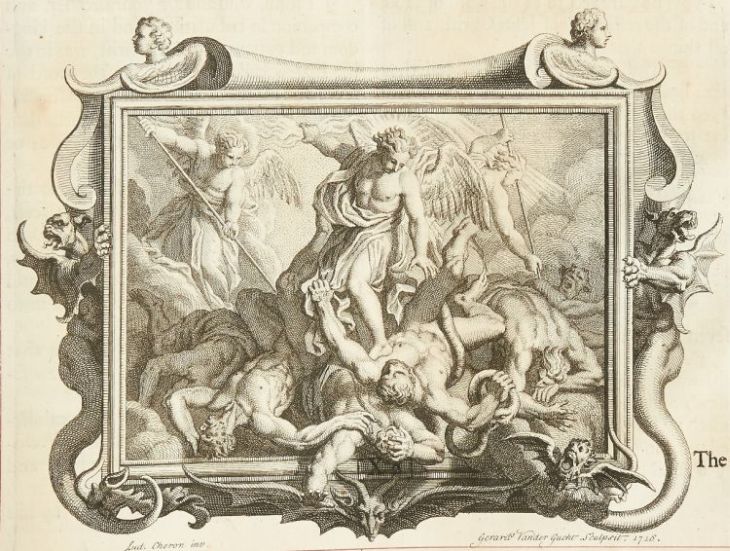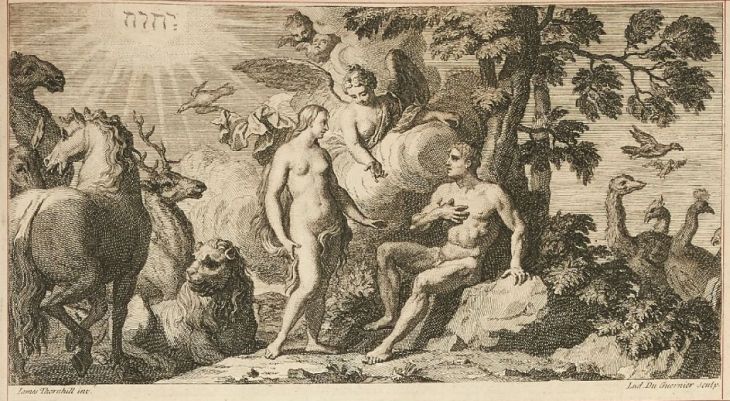In 1709, John Baskett, purchased the exclusive, royal patent to print Bibles in England. His edition of the Bible is also his most important work and is described by Darlow/Moule as: “A magnificent edition, printed in large type. With many plates at the beginning and end of books, engraved on steel from the designs of various artists. Some of the initial letters are similarly engraved. Unfortunately the book contained many misprints and earned the nickname A Baskett-ful of Errors…. From the misprint The parable of the vinegar (for vineyard) in the headline above Luke XX, this edition is commonly known as the Vinegar Bible.” 1
Darlow/Moule identifies two varieties of the book:
A. The additional general title, engraved by Du-Bose, represents Moses writing the first words of Genesis; below is the imprint Printed by Jn. Baskett at the Clarendon Printing-house in Oxford. The other general title has a view of Oxford by G. Vander Gucht. The New Testament title bears an engraving of the Annunciation. 490 x 307 mm.
B. The additional general title, engraved by Sturt, represents a church interior, with figures of Moses and Aaron, etc.; and dated 1716. The other general title and New Testament title have small engravings. In the text the columns are separated by a double rule. The engravings differ significantly from those in A; many represent allegorical subjects, and others are merely ornamental pieces, and do not, as in A, generally illustrate Bible incidents. 503 x 305 mm. 2
While both scholars and collectors today esteem the Vinegar Bible as one of the most beautiful and legible editions of Scripture ever published, the distinctions between the two variants are harder to spot. The difference in the measurements, for example, is unreliable since most of the surviving copies were rebound and sometimes cut. Even the most important difference between the two variants, the copper-engraved artwork, is mixed up with some volumes containing engravings by du-Bose as well as Sturt, and others. This was the case with a copy of variant “A”, sold by book dealer Bauman Rare for $18,500. This copy, in addition to the general title depicting Moses’ writing of the first word of Genesis, includes the general title page engraved by Sturt, depicting a church interior with figures of Aaron and Moses, generally found in Variant “B”.
Another configuration of mixed volumes (Old Testament variant “A” and New Testament variant “B”) is much less desirable, despite Variant “B” being rarer. Such a copy, having the additional setback of separated covers and some loss to the gilt dentelle, was sold in May of 2014, by Liveauctioneers, for a mere $1,300.
Prior sales are primarily of variant “A”. In November of 1997, Christie’s auctioned a fine copy of variant “A” in red morocco title-label binding, with hand-marbled endpapers for GBP 3,220 or USD 5,389. A year later, Christie’s sold, at the McKenna Library Sale Part II event, another copy with all of the characteristics of “A”; with contemporary dark blue morocco binding, and a few repaired tears, for GBP 4,600 or USD 7,608. In July of 2000, Christie’s sold yet another copy of the ‘A’ variant in a contemporary Oxford black goatskin binding. This copy, which was in average condition with the lower corner torn from title, occasional heavy browning, tears and some holes, sold for GBP 4,112 or USD 6,185. A much less desirable copy, in a contemporary red morocco, featuring the engraved view of Oxford, by G. Vander Gucht, and having the top edge of the title trimmed, browning and spotting throughout, with small stains, marginal repairs, joints splitting and detachment, sold in 2013, for GBP 1,875 or USD 3,015.
John Baskett’s Bibles with the mistakes corrected are not very exciting to collectors. At the end of 2016, a later edition in below average condition with internal tears and holes, some leaves missing, but with the correct wording of “vineyard” after a press change, sold at Sotheby’s for $2,750. During the same time, Doyle Rare Books, Autographs & Photographs, auctioned the two volumes of variant “A”, bound in contemporary dark-blue goatskin with joints discreetly repaired at the head and foot, with the bookplates of Sir John Hynde for $12,500 (including buyer’s premium).
The scarcity of variant “B” relative to variant “A” is not necessarily attributed to differences in production sizes. Demand for the artistic ornamentation of John Sturt, who also illustrated The Pilgrim’s Progress, was quite high at the time. Another well known contributor to the artwork in “B” was artist engraver, James Thornhill, one of the most important English exponents of Baroque decorative painting, and the first English-born artist to be knighted. The Vinegar Bible was a true landmark in English graphic art, celebrated by the monarchs/owners of the time, for the beauty of its ornamentation and typographical design, errors and all aside.
1 Historical Catalogue of the Printed Editions of Holy Scripture in the Library of the British and Foreign Bible Society, Library Bible House, 1903 Volume 1, p.259.
2 Historical Catalogue of the Printed Editions of Holy Scripture in the Library of the British and Foreign Bible Society, Library Bible House, 1903 Volume 1, p.259-260.




{ 0 comments… add one now }